Printing Invoices
There are several occasions when you may want to print an Invoice: to view a test print-out to check the Invoice before you finally approve it; to produce a copy for your own files, or to send the original Invoice to the Customer.
To produce a test print-out, save the Invoice without marking it as OK and then click the Printer icon in the Button Bar. The Invoice will be printed. If you are not using the No Test Printout option in the Optional Features setting in the System module, the text "Test Printout" will be printed diagonally across the page as a watermark. This is to avoid the test being confused with the final version. As you have not yet marked the Invoice as OK, you can go back and correct any errors you may find in the printout. This is also true for Credit Notes.
After you have marked the Invoice as OK and saved it, you can again print it simply by clicking the Printer icon. You can also print a range of final Invoices at one stroke: to do so, follow the instructions below:
- Click the [Forms] button in the Navigation Centre or use the Ctrl-D/⌘-D keyboard-shortcut. Double-click 'Invoices' in the resulting list.
The 'Specify Invoices' window is shown.
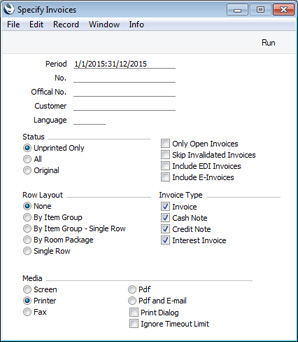
- Enter the Invoice Number for a single Invoice, or the highest and lowest Invoice Numbers of a range of Invoices separated by a colon (:). Use the Status options to specify which Invoices are to be printed:
- Unprinted Only
- Choose this option if you only want to print Invoices in the range that have not previously been printed. Only Invoices in the range that have been marked as OK will be printed.
- All
- This option will print every Invoice in the range. If you are not using the No Test Printout option, any previously printed Invoices will have the word "Copy" printed diagonally across the page as a watermark, while any Invoices that have not been marked as OK will be printed with a "Test Printout" watermark.
- Original
- This option will also print every Invoice in the range. Invoices that have been marked as OK and that have already been printed will be printed again as though they were original copies, without the "Copy" watermark, irrespective of whether you are using the No Test Printout option. Invoices that have not been marked as OK will carry the "Test Printout" watermark if you are not using the No Test Printout option.
Use the Invoice Type check boxes to limit your selection to specific kinds of Invoice, as described in step 7 below.
- Press [Run] in the Button Bar to start the printing, or cancel by closing the window.
If you would like Invoices to be printed automatically when you save them after marking them as OK, select the
At OK option in the
Auto Actions setting in the System module:
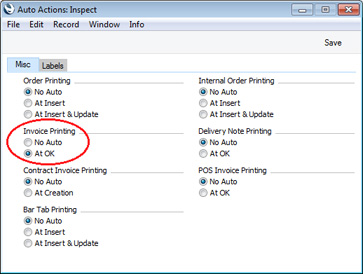
When you print an Invoice using any of the methods described above, it will be printed using a Form Template. The Form Template contains the graphic layout design of the printed output i.e. it determines where on the page each piece of information will be placed. Therefore, before you can begin printing Invoices, you should design a Form Template (step 1 below), and then specify that the particular Form Template will be used when printing Invoices (steps 2-7):
- Design the Invoice Form Template using the Form Template register in the System module. Use the 'Properties' function on the Operations menu to name the Form Template (in this description, we have used the name "INVOICE") and to assign it a Form Type of "Invoice". A full list of the fields you can include in the Template design can be found here.
A file containing samples of each Form Template including a sample "INVOICE" is supplied with Standard ERP: if you want to use these samples as templates for your own designs, import the "UKForms.txt" file as described on the Importing Set-up Data page.
- Having designed the Invoice Form Template, you should now specify that it should be used when printing Invoices. Select the Sales Ledger using the [Switch Module] button in the Navigation Centre or the Ctrl-0 (Windows and Linux) or ⌘-0 (Mac OS X) keyboard shortcuts.
- Click the [Forms] button in the Navigation Centre or use the Ctrl-D/⌘-D keyboard shortcut. The 'Forms' list window will be opened: highlight 'Invoices'.
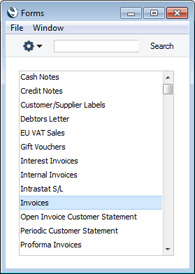
- Select 'Define Form' from the Operations menu (with "cog" icon):
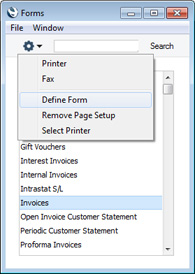
- In the subsequent 'Form Definition' window, enter "INVOICE" in the Form Template field in the first row (you can use 'Paste Special' to ensure the spelling is correct).
If you only want to be able to print Invoices that have been marked as OK, enter "OKed" in the Status column in every row in the 'Form Definition' window. This will prevent the printing of Invoices that have not yet been marked as OK. If you have also used Access Groups to specify which users are able to mark Invoices as OK, this feature helps prevent the fraudulent creation and printing of unauthorised Invoices.
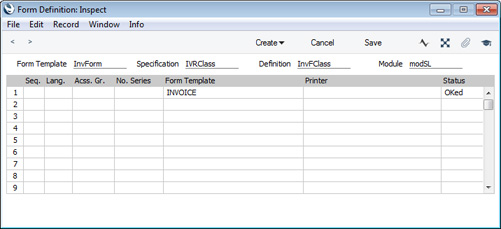
You can also use this feature to use a different Form Template when printing Invoices that have not been marked as OK, as shown below:
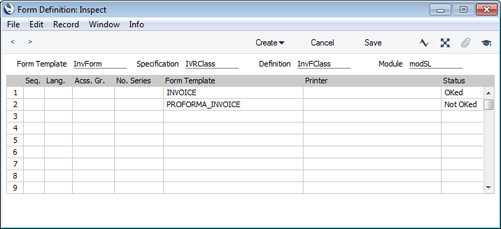
- Click [Save] to save the Invoice Form definition. From now on, the invoice Form Template that you have designed will be used when you print Invoices using the 'Forms' function and the Printer icon, except as described in step 7 below.
- Cash Notes, Credit Notes, Interest Invoices and Project Invoices will be printed using different Form Templates. You must therefore specify which Form Template is to be used in each case before you can begin printing. It may be that you decide to use the same Form Template for each Invoice type, but if so, you must still explicitly connect the Form Template to each Invoice type separately.
To do this, repeat the previous six steps in turn to specify the Form Templates that will be used when you print Invoices of each type. In step 3, highlight 'Cash Notes', 'Credit Notes', 'Interest Invoices' and 'Project Invoices' as appropriate in the 'Forms' list window.
These Form Templates will be used instead of the standard Invoice Form Template in the following circumstances:
- Cash Note
- If the Invoice has a Payment Term of the "Cash" Type, the Cash Note Form Template will be used instead of the Invoice Form Template.
- Credit Note
- If the Invoice has a Payment Term of the "Credit Note" Type, the Credit Note Form Template will be used instead of the Invoice Form Template.
- Interest Invoice
- If the Invoice was created using the 'Create Interest Invoices' Maintenance function or it has a Payment Term of the "Manual Interest Inv." Type, the Interest Invoice Form Template will be used instead of the Invoice Form Template.
- Project Invoice
- If the Project field on the 'Identifiers' card of the Invoice contains a value, the Project Invoice Form Template will be used instead of the Invoice Form Template.
In each of the four cases described above, if the form does not have an associated Form Template (steps 4-6 above), Standard ERP will display the message "No form defined. Please check the form definition" when you try to print an Invoice. If you get this warning, check the type of the Invoice to see which one is missing its Form Template.
In the Form Template that will be used when printing Invoices, you can specify using the
'Copies' function on the Operations menu that several copies are to be printed, perhaps on different printers. These copies will only be printed the first time you print an Invoice after marking it as OK and saving. If you print the Invoice again, or print it before you have marked it as OK, only one copy will be printed. If you need to print all copies again, you must print the Invoice using the 'Forms' function (i.e. not by clicking the Printer icon in the Invoice record), and you should choose the
Original option.
You can use Access Groups to prevent certain users from reprinting Invoices (both from the Printer icon and when using the 'Forms' function). To prevent the reprinting of Invoices, grant Full access to the 'Disallow Printing Copies' Action. This Action will also prevent the printing of Invoices that have not been marked as OK.
By default, you will not be able to print an Invoice that has been sent electronically by opening it and clicking the Printer icon. If you would like this to be possible for some users, use Access Groups to grant those users Full access to the 'Allow Printing Electronic Invoices from Invoice Record' Action. The sending of Invoices electronically is a chargeable Cloud Service that is available in several countries. To use it, you must have registered your database using the Automatic Internet Enabler method, as described on the Enabler Key page. Please contact your local HansaWorld representative for pricing and configuration details.
If you need Invoices to pass through an approval process before you can print them, you can configure such a process using the Approval Rules register in the Business Alerts module. Please refer to the description of the Approval Status field on the 'Inv. Address' card of the Invoice window for brief details about the approval process and here for full details.
---
The Invoice register in Standard ERP:
Go back to:
